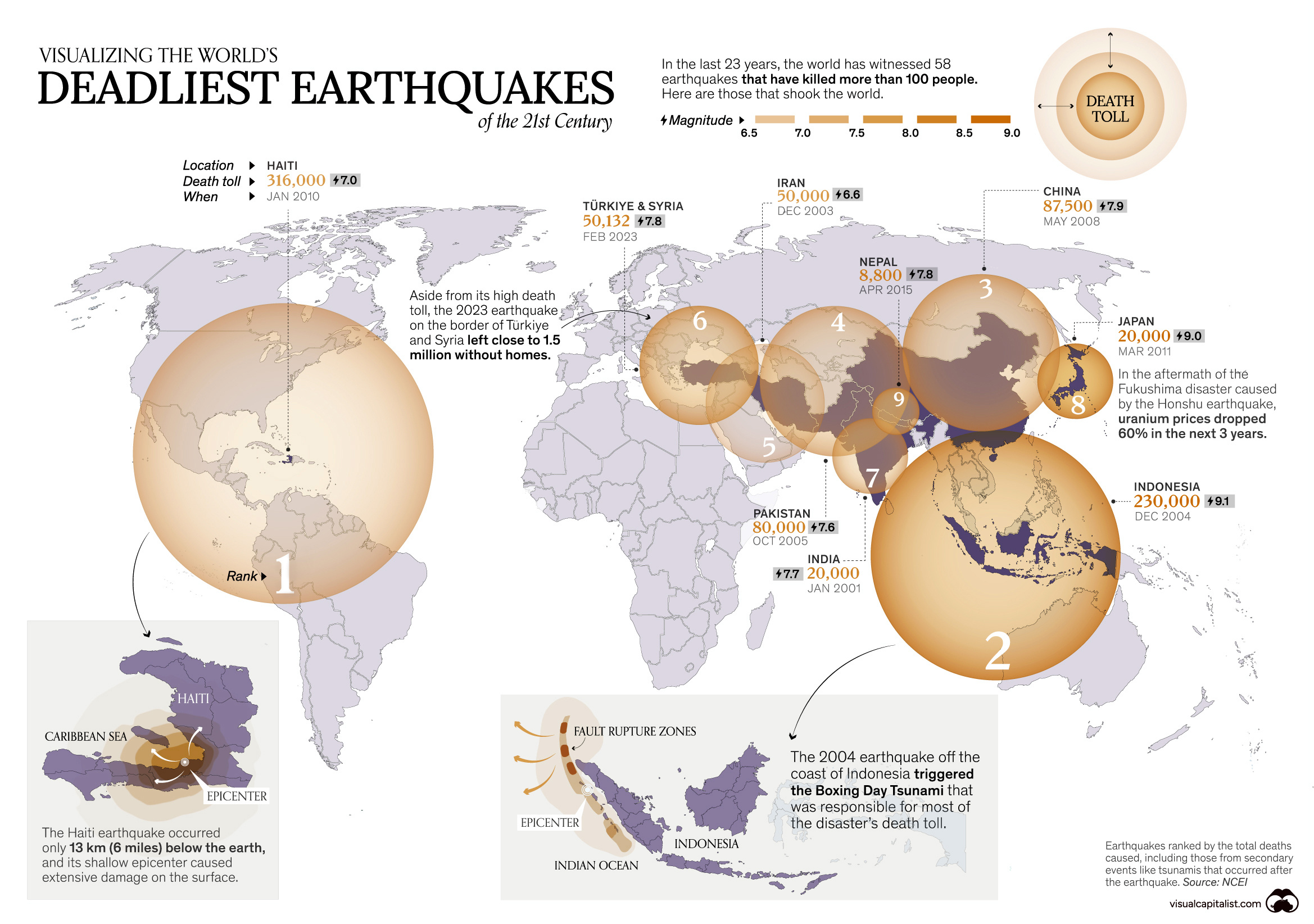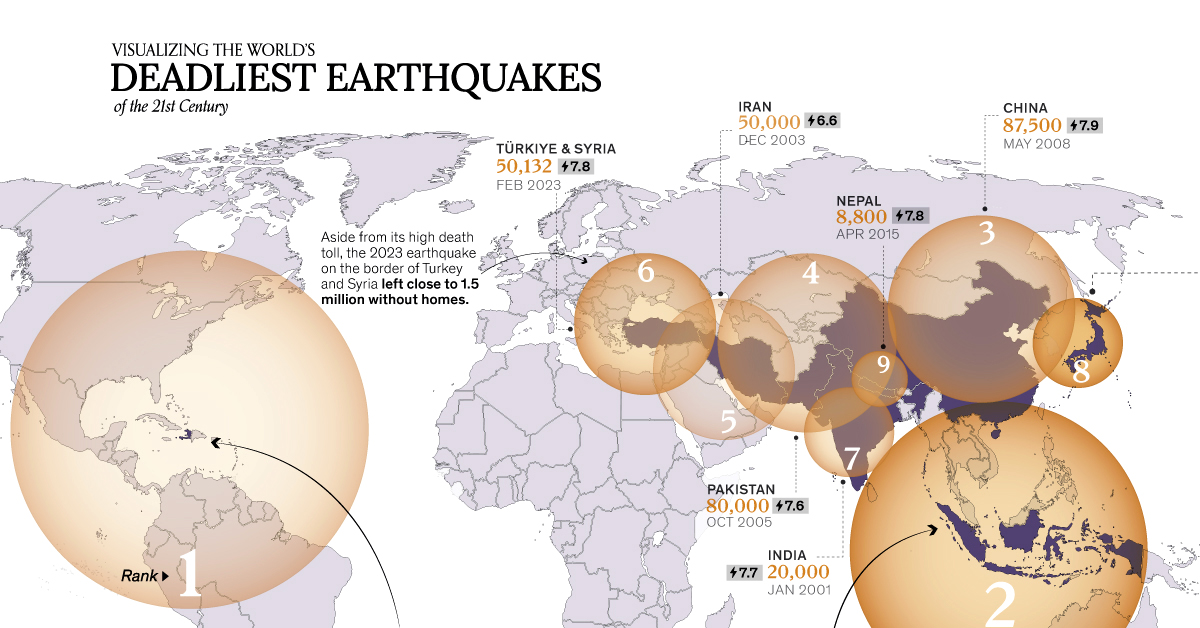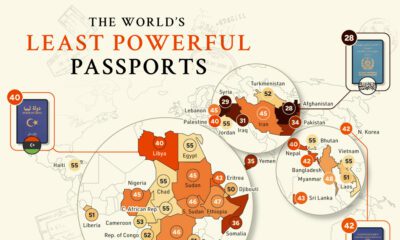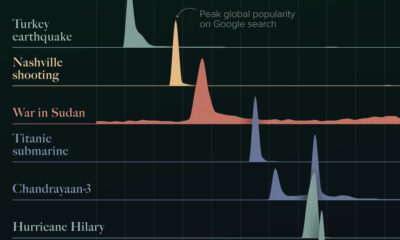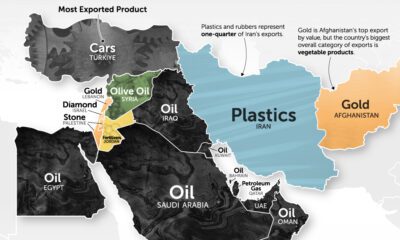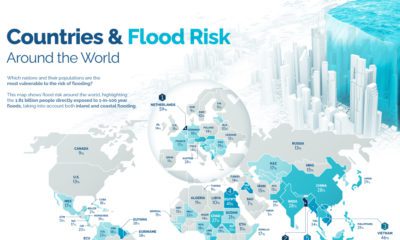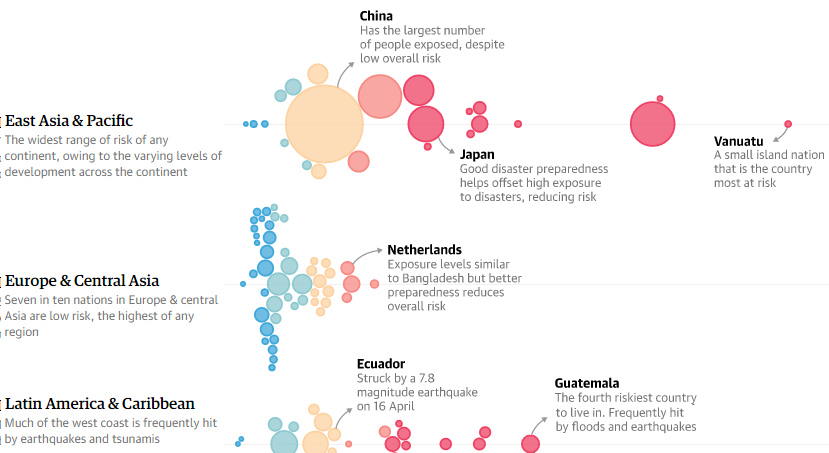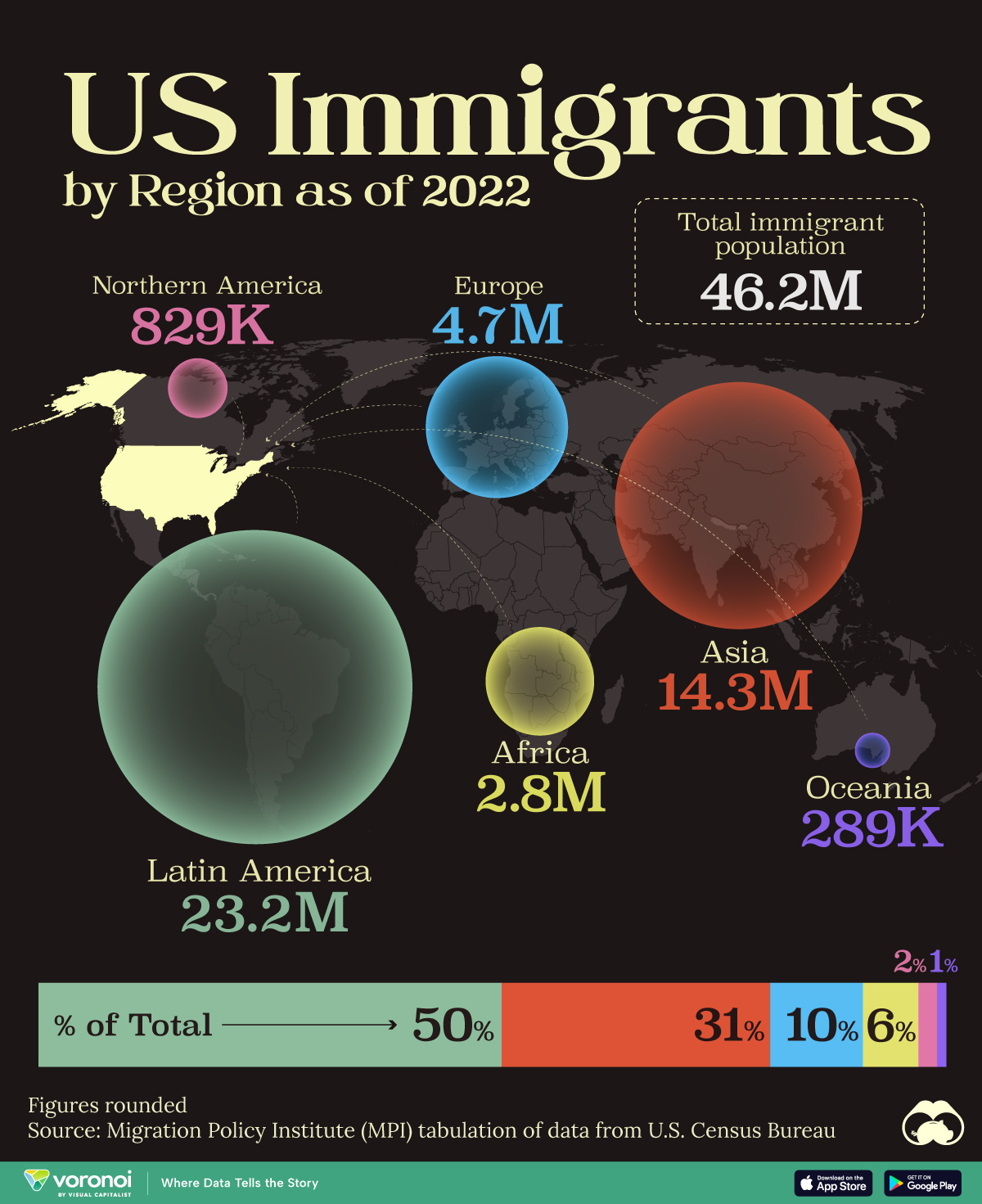Maps
Mapped: The Deadliest Earthquakes of the 21st Century
View the full-size earthquake map
Mapped: The Deadliest Earthquakes of the 21st Century
On September 8, 2023, a powerful earthquake rocked Morocco. With its epicenter located in the Atlas Mountains and structural damage being done to the historical city center of Marrakesh, the 6.8-magnitude quake will likely have a death toll in the thousands.
With these recent events in mind, we use data from the National Centers for Environment Information (NCES) to map out the epicenters of the nine deadliest earthquakes in the 21st century so far, by their total death toll. This includes casualties from secondary events—like tsunamis—after each earthquake.
Earthquakes By Death Toll (2000–2023)
We delve into some of the deadliest earthquakes in recent history.
Haiti, 2010
On January 12th, 2010, a 7.0 magnitude earthquake hit the capital Port-au-Prince. The earthquake’s shallow epicenter—only six miles beneath the surface—caused most of the force to be directed close to where people lived. By the end of the month, after 52 aftershocks rocked the island, the disaster had claimed more than 300,000 lives—the deadliest earthquake in the 21st century thus far.
The extensive destruction led to global support, but slow recovery sparked criticism of government inaction. In 2017, the UN reported 2.5 million Haitians still required aid.
Indonesia, 2004
December 26th, 2004: A 9.1 earthquake occurred off the coast of Indonesia, deep under the ocean. It was the strongest earthquake in this century and the third-most powerful since 1900.
It triggered the worst tsunami recorded in history, causing 230,000 deaths mainly in Indonesia, Sri Lanka, Thailand, and India.
Here’s a list of the deadliest earthquakes, by death toll, in the 21st century.
| Rank | Date | Location | Total Deaths | Magnitude |
|---|---|---|---|---|
| 1 | Jan, 2010 | 🇭🇹 Haiti | 316,000 | 7.0 |
| 2 | Dec, 2004 | 🇮🇩 Indonesia | 227,899 | 9.1 |
| 3 | May, 2008 | 🇨🇳 China | 87,652 | 7.9 |
| 4 | Oct, 2005 | 🇵🇰 Pakistan | 76,213 | 7.6 |
| 5 | Feb, 2023 | 🇹🇷 Türkiye | 56,697 | 7.8 |
| 6 | Dec, 2003 | 🇮🇷 Iran | 31,000 | 6.6 |
| 7 | Jan, 2001 | 🇮🇳 India | 20,005 | 7.6 |
| 8 | March, 2011 | 🇯🇵 Japan | 18,428 | 9.1 |
| 9 | April, 2015 | 🇳🇵 Nepal | 8,957 | 7.8 |
| 10 | May, 2006 | 🇮🇩 Indonesia | 5,749 | 6.3 |
| 11 | Sep, 2018 | 🇮🇩 Indonesia | 4,340 | 7.5 |
| 12 | May, 2003 | 🇩🇿 Algeria | 2,287 | 6.8 |
| 13 | Aug, 2021 | 🇭🇹 Haiti | 2,248 | 7.2 |
| 14 | April, 2010 | 🇨🇳 China | 2,220 | 6.9 |
| 15 | March, 2005 | 🇮🇩 Indonesia | 1,313 | 8.6 |
| 16 | Sep, 2009 | 🇮🇩 Indonesia | 1,117 | 7.5 |
| 17 | June, 2022 | 🇦🇫 Afghanistan | 1,039 | 5.9 |
| 18 | March, 2002 | 🇦🇫 Afghanistan | 1,000 | 6.1 |
| 19 | Jan, 2001 | 🇸🇻 El Salvador | 844 | 7.7 |
| 20 | Sep, 2013 | 🇵🇰 Pakistan | 825 | 7.7 |
| 21 | July, 2006 | 🇮🇩 Indonesia | 802 | 7.7 |
| 22 | April, 2016 | 🇪🇨 Ecuador | 663 | 7.8 |
| 23 | Nov, 2022 | 🇮🇩 Indonesia | 635 | 5.6 |
| 24 | Nov, 2017 | 🇮🇷 Iran | 630 | 7.3 |
| 25 | Feb, 2004 | 🇲🇦 Morocco | 628 | 6.4 |
| 26 | Aug, 2014 | 🇨🇳 China | 615 | 6.2 |
| 27 | Feb, 2005 | 🇮🇷 Iran | 612 | 6.4 |
| 28 | Oct, 2011 | 🇹🇷 Turkey | 604 | 7.1 |
| 29 | Aug, 2018 | 🇮🇩 Indonesia | 560 | 6.9 |
| 30 | Feb, 2010 | 🇨🇱 Chile | 558 | 8.8 |
| 31 | Aug, 2007 | 🇵🇪 Peru | 514 | 8.0 |
| 32 | Oct, 2010 | 🇮🇩 Indonesia | 431 | 7.8 |
| 33 | Oct, 2015 | 🇦🇫 Afghanistan | 399 | 7.5 |
| 34 | Sep, 2017 | 🇲🇽 Mexico | 369 | 7.1 |
| 35 | Feb, 2001 | 🇸🇻 El Salvador | 315 | 6.6 |
| 36 | April, 2009 | 🇮🇹 Italy | 309 | 6.3 |
| 37 | Aug, 2012 | 🇮🇷 Iran | 306 | 6.5 |
| 38 | Aug, 2016 | 🇮🇹 Italy | 299 | 6.2 |
| 39 | June, 2002 | 🇮🇷 Iran | 261 | 6.5 |
| 40 | Feb, 2003 | 🇨🇳 China | 261 | 6.3 |
| 41 | Oct, 2013 | 🇵🇭 Philippines | 222 | 7.1 |
| 42 | Oct, 2008 | 🇵🇰 Pakistan | 215 | 6.4 |
| 43 | April, 2013 | 🇨🇳 China | 196 | 6.6 |
| 44 | Sep, 2009 | 🇼🇸 Samoa Islands | 192 | 8.1 |
| 45 | Feb, 2011 | 🇳🇿 New Zealand | 185 | 6.1 |
| 46 | May, 2003 | 🇹🇷 Turkey | 177 | 6.4 |
| 47 | March, 2002 | 🇦🇫 Afghanistan | 166 | 7.4 |
| 48 | Feb, 2018 | 🇵🇬 Papua New Guinea | 145 | 7.5 |
| 49 | Oct, 2020 | 🇬🇷 Greece | 118 | 7.0 |
| 50 | Sep, 2022 | 🇨🇳 China | 118 | 6.6 |
| 51 | May, 2015 | 🇳🇵 Nepal | 117 | 7.3 |
| 52 | Feb, 2016 | 🇹🇼 Taiwan | 117 | 6.4 |
| 53 | Sep, 2011 | 🇮🇳 India | 111 | 6.9 |
| 54 | Jan, 2021 | 🇮🇩 Indonesia | 105 | 6.2 |
| 55 | March, 2011 | 🇲🇲 Myanmar | 104 | 6.8 |
| 56 | Dec, 2016 | 🇮🇩 Indonesia | 104 | 6.5 |
| 57 | June, 2000 | 🇮🇩 Indonesia | 103 | 7.9 |
| 58 | June, 2001 | 🇵🇪 Peru | 103 | 8.4 |
Türkiye and Syria, 2023
February 6, 2023: Two earthquakes, also with shallow epicenters (5 miles deep), hit the border region between Türkiye and Syria, causing widespread damage in both countries and claiming more than 50,000 lives. Bad weather conditions—including snow, ice, and winter storms—inhibited search and rescue efforts.
In Syria, international sanctions prevented foreign charities and families from sending money to the country, which led to the U.S. suspending the sanctions for 180 days.
Japan, 2011
March 11, 2011: Another undersea earthquake—also 9.1 magnitude—occurred off the coast of Japan, triggering a deadly tsunami which flattened parts of the country 30 minutes later.
The high waves also damaged Fukushima’s Nuclear Plant’s emergency diesel generators leading to reactor meltdowns, and a release of radioactive waste. In total, 18,000 people lost their lives from the earthquake and tsunami.
How Does Earthquake Data Help With Disaster Preparedness?
Thanks to the study of plate tectonics, scientists know where earthquakes usually occur, even if they don’t know when precisely. For example countries along the “Ring of Fire”—a hotbed of earthquake and volcanic activity—witness hundreds of earthquakes a year, though most are not strong enough to cause any damage.
However, with deadly earthquakes, other factors, including epicenter depth, location near populous areas, and proximity to secondary events—tsunamis—can play a far bigger role in death tolls.
Disaster preparedness and swift government action can mitigate many secondary casualties as seen comparing the vastly different death tolls of the 2004 and 2011 tsunamis.
Demographics
Mapped: U.S. Immigrants by Region
This map shows which regions U.S. immigrants came from, highlighting Asia and Latin America as the biggest sources.
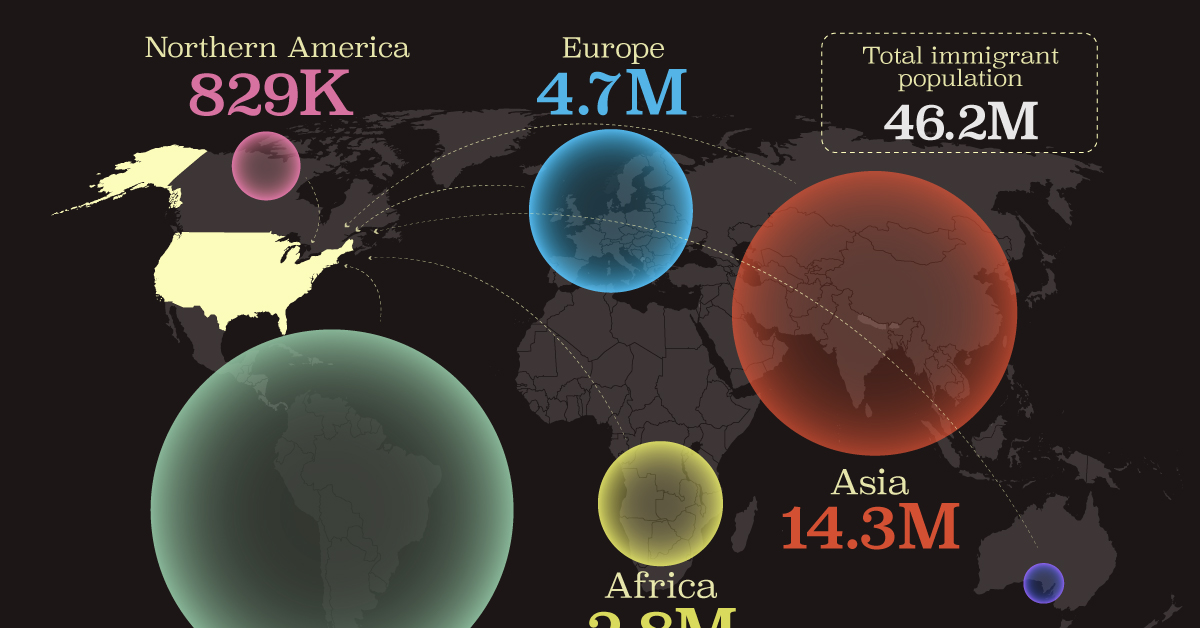
Breaking Down America’s Immigrant Population
This was originally posted on our Voronoi app. Download the app for free on iOS or Android and discover incredible data-driven charts from a variety of trusted sources.
The United States is home to more immigrants than any other nation, surpassing the combined totals of the next four countries: Germany, Saudi Arabia, Russia, and the United Kingdom.
To add context to this impressive fact, we’ve illustrated the regions from which U.S. immigrants originated. “Immigrants” in this context refers to individuals who are residing in the United States but were not U.S. citizens at birth.
These statistics were sourced from the Migration Policy Institute, which analyzed data from the U.S. Census Bureau’s 2022 American Community Survey (ACS).
U.S. Immigrants by Region
From this graphic, we can see that Asia and Latin America emerge as the primary sources of immigration, collectively accounting for 81% of America’s 46.2 million immigrants.
| Region | # of Immigrants | % of Total |
|---|---|---|
| Europe | 4,728,948 | 10 |
| Asia | 14,349,080 | 31 |
| Africa | 2,752,965 | 6 |
| Oceania | 288,560 | 1 |
| Northern America | 828,702 | 2 |
| Latin America | 23,233,834 | 50 |
| Total | 46,182,089 | 100 |
Latin America alone contributes half of the immigrant population. Mexico stands out as the largest contributor to U.S. immigration, with 10.7 million immigrants, attributable to its geographical proximity and historical ties.
Economic factors, including wage disparity and employment opportunities, drive many Mexicans to seek better prospects north of the border.
From Asia, the two largest country sources are China (2.2 million) and India (2.8 million).
Learn More About U.S. Immigration From Visual Capitalist
If you enjoyed this post, be sure to check out Why Do People Immigrate to the U.S.? This visualization shows the different reasons why immigrants chose to come to America in 2021.
-

 Technology5 days ago
Technology5 days agoMapped: The Number of AI Startups By Country
-

 Markets2 weeks ago
Markets2 weeks agoThe Best U.S. Companies to Work for According to LinkedIn
-

 Economy2 weeks ago
Economy2 weeks agoRanked: The Top 20 Countries in Debt to China
-

 Politics2 weeks ago
Politics2 weeks agoCharted: Trust in Government Institutions by G7 Countries
-

 Energy2 weeks ago
Energy2 weeks agoMapped: The Age of Energy Projects in Interconnection Queues, by State
-

 Mining2 weeks ago
Mining2 weeks agoVisualizing Global Gold Production in 2023
-

 Markets1 week ago
Markets1 week agoVisualized: Interest Rate Forecasts for Advanced Economies
-

 Economy1 week ago
Economy1 week agoThe Most Valuable Companies in Major EU Economies

